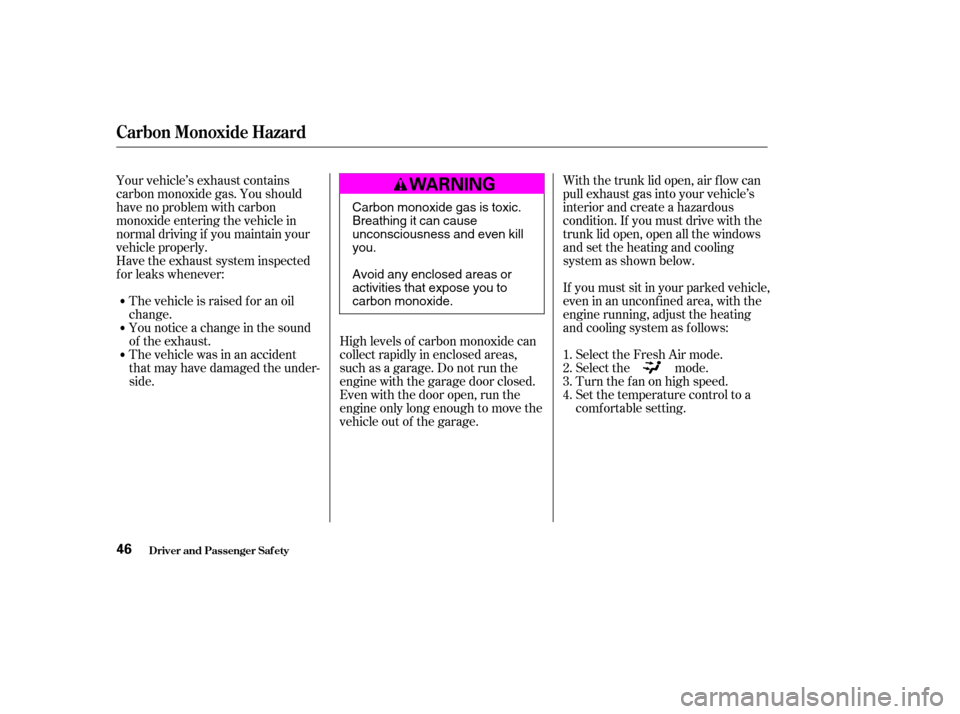Page 45 of 221

Your vehicle’s exhaust contains
carbon monoxide gas. You should
have no problem with carbon
monoxide entering the vehicle in
normal driving if you maintain your
vehicle properly.High levels of carbon monoxide can
collect rapidly in enclosed areas,
such as a garage. Do not run the
engine with the garage door closed.
Even with the door open, run the
engine only long enough to move the
vehicle out of the garage.With the trunk lid open, air f low can
pull exhaust gas into your vehicle’s
interior and create a hazardous
condition. If you must drive with the
trunk lid open, open all the windows
and set the heating and cooling
system as shown below.
If you must sit in your parked vehicle,
even in an unconf ined area, with the
engine running, adjust the heating
and cooling system as f ollows:
Select the Fresh Air mode.
Select the mode.
Turn the f an on high speed.
Set the temperature control to a
comfortable setting.
Have the exhaust system inspected
f or leaks whenever:
The vehicle is raised f or an oil
change.
You notice a change in the sound
of the exhaust.
The vehicle was in an accident
that may have damaged the under-
side. 1.2.3.4.
Carbon Monoxide Hazard
Driver and Passenger Saf ety46
Carbon monoxide gas is toxic.
Breathing it can cause
unconsciousness and even killyou.
Avoid any enclosed areas or
activities that expose you to
carbon monoxide.
�����—�����—�����y�
����
��������y���
�(�����������y���������y
Page 50 of 221
The U.S. instrument panel is shown. Dif f erences f or the Canadian models are noted in thetext.
Instrument Panel
Inst rument s and Cont rols
L X, U.S. EX, and Canadian Si models
51
MALFUNCTION INDICATOR LAMP
SHIFT LEVER POSITION INDICATORANTI-LOCK BRAKE
SYSTEM INDICATOR
PARKING BRAKE AND
BRAKE SYSTEM
INDICATOR
TRUNK-OPEN INDICATOR
MAINTENANCE
REQUIRED INDICATOR
LOW FUEL INDICATOR
IMMOBILIZER SYSTEM
INDICATOR
SUPPLEMENTAL RESTRAINT
SYSTEM INDICATOR
LOW OIL PRESSURE
INDICATOR HIGH BEAM INDICATOR
SEAT BELT REMINDER LIGHT
CRUISE CONTROL INDICATOR
SIDE AIRBAG CUTOFF INDICATOR
CHARGING SYSTEM
INDICATOR
(P. 55)
(P. 56)
(P. 56)
(P. 55, 182)
(P. 55, 182) (P. 183) (P. 128) (P. 54) (P. 57)
(P. 54) (P. 54)
(P. 55)
(P. 56)
(P. 58)
(P. 56)
�����—�����—�����y�
�������������y���
�(�����������y���������y
Page 51 of 221
Instrument Panel
Inst rument s and Cont rols
Canadian DX model
52
LOW OIL PRESSURE
INDICATORDAYTIME RUNNING
LIGHTS INDICATOR
MALFUNCTION INDICATOR LAMP HIGH BEAM INDICATOR WASHER LEVEL
INDICATOR
TRUNK-OPEN INDICATOR
SIDE AIRBAG CUTOFF INDICATOR
IMMOBILIZER SYSTEM
INDICATOR
CHARGING SYSTEM
INDICATOR SEAT BELT
REMINDER LIGHTMAINTENANCE REQUIRED
INDICATOR PARKING BRAKE AND
BRAKE SYSTEM
INDICATOR
LOW FUEL INDICATOR
SUPPLEMENTAL RESTRAINT SYSTEM INDICATOR
(P. 54)
(P. 57)
(P. 55, 182)
(P. 55, 182) (P. 183) (P. 56)
(P. 54)
(P. 57)
(P. 56)
(P. 56)
(P. 55)
(P. 54) (P. 56)
(P. 58)
�����—�����—�����y�
�������������y���
�(�����������y���������y
Page 52 of 221
Instrument Panel
Inst rument s and Cont rols
U.S. DX model
53
SUPPLEMENTAL RESTRAINT SYSTEM INDICATOR
LOW OIL PRESSURE
INDICATOR MALFUNCTION INDICATOR LAMP HIGH BEAM INDICATORSIDE AIRBAG CUTOFF INDICATOR
TRUNK-OPEN INDICATOR
CHARGING SYSTEM
INDICATOR SEAT BELT
REMINDER LIGHTMAINTENANCE REQUIRED
INDICATOR PARKING BRAKE AND
BRAKE SYSTEM
INDICATOR
IMMOBILIZER SYSTEM
INDICATOR
LOW FUEL INDICATOR
(P. 54)
(P. 57)
(P. 55, 182)
(P. 55, 182)
(P. 183) (P. 56)
(P. 54)
(P. 56)
(P. 55)
(P. 58)
(P. 56)
(P. 54)
�����—�����—�����y�
�������������y���
�(�����������y���������y
Page 54 of 221

If this indicator comes on when the
engine is running, the battery is not
being charged. For complete
inf ormation, see page .
The engine can be severely damaged
if this light f lashes or stays on when
the engine is running. For complete
inf ormation, see page .This indicator has two f unctions:
If it remains lit af ter you have f ully
released the parking brake while
the engine is running, or if it
comes on while driving, there
could be a problem with the brake
system. For complete inf ormation,
see page .
Itcomesonwhenyouturnthe
ignition switch to ON (II). It is a
reminder to check the parking
brake. Driving with the parking
brake not f ully released can
damage the brakes and tires.
This indicator normally comes on f or
a f ew seconds when you turn the
ignition switch to ON (II), and when
the ignition switch is turned to
START (III). If it comes on at any
other time, there is a problem in the
ABS. If this happens, have your
vehicle checked at a dealer. With
this light on, your vehicle still has
normal braking ability but no anti-
lock. For complete inf ormation, see
page .
1. 2.
182
182 133
184Only on models equipped with ABS (see page ) 133
Instrument Panel L ights
Inst rument s and Cont rols
Charging System
Indicator
L ow Oil Pressure
Indicator Parking Brake
and Brake
System
Indicator
Anti-lock Brake System
(A BS) Indicator
55
U.S. Canada
�����—�����—�����y�
������
������y���
�(�����������y���������y
Page 111 of 221

Help assure your vehicle’s f uture
reliability and perf ormance by paying
extra attention to how you drive
during the f irst 600 miles (1,000 km).
During this period:Avoid full-throttle starts and rapid
acceleration.
Avoidhardbrakingforthefirst
200 miles (300 km).
Do not change the oil until the
scheduled maintenance time.
You should also f ollow these re-
commendations with an overhauled
or exchanged engine, or when the
brakes are replaced. Your Honda is designed to operate
on unleaded gasoline with a pump
octane number of 86 or higher. Use
of a lower octane gasoline can cause
a persistent, heavy metallic rapping
noise in the engine that can lead to
mechanical f ailure.
We recommend using a gasoline
containing detergent additives that
help prevent f uel system and engine
deposits.
In addition, in order to maintain good
perf ormance, f uel economy, and
emissions control, we strongly
recommend, in areas where it is
available, the use of gasoline that
does NOT contain manganese-based
f uel additives such as MMT.
Use of gasoline with these additives
may adversely af f ect perf ormance,
and cause the Malfunction Indicator
Lamp on your instrument panel to
come on. If this happens, contact
your authorized Honda dealer f or
service.
Some gasoline today is blended with
oxygenates such as ethanol or
MTBE. Your vehicle is designed to
operate on oxygenated gasoline
containing up to 10 percent ethanol
by volume and up to 15 percent
MTBE by volume. Do not use
gasoline containing methanol.
For f urther important f uel-related
inf ormation, please ref er to your
Quick Start Guide.
Break-in Period, Gasoline T ype
Bef ore Driving
Break-in Period Gasoline Type
112
�����—�����—�����y�
�������������y���
�(�����������y���
�
���y
Page 114 of 221
Wait a f ew minutes af ter turning the
engine of f bef ore you check the oil.Remove the dipstick (orange loop).
Wipe the dipstick with a clean
cloth or paper towel.
Insert it all the way back in its tube. Remove the dipstick again and
check the level. It should be
between the upper and lower
marks.
If it is near or below the lower mark,
see on page . Look at the coolant level in the
radiator reserve tank. Make sure it is
between the MAX and MIN lines. If
it is below the MIN line, see
on page f or
inf ormation on adding the proper
coolant.
Refer to on page f or inf ormation
on checking other items in your
Honda.
2. 3.
1.
4.
144 138147
Bef ore Driving
Oil Check
A dding Oil A dding
Engine Coolant
Engine Coolant Check
Owner’s Maintenance
Checks
Service Station Procedures
115
DIPSTICK UPPER MARK
LOWER MARKRESERVE TANK
MINMAX
�����—�����—�����y�
������
������y���
�(�����������y���
�
���y
Page 134 of 221

This section also includes
Maintenance Schedules f or normal
driving and severe driving conditions,
a Maintenance Record, and instruc-
tions f or simple maintenance tasks
you may want to take care of
yourself .
If you have the skills and tools to per-
f orm more complex maintenance
tasks on your Honda, you may want
to purchase the Service Manual. See
page f or inf ormation on how to
obtain a copy, or see your Honda
dealer.
This section explains why it is
important to keep your vehicle well
maintained and how to f ollow basic
maintenance saf ety precautions.
......................
Maintenance Saf ety . 136
.................
Maintenance Schedule . 137
....................
Maintenance Record . 141
..............................
Fluid Locations . 143
........................
Adding Engine Oil . 144
.........
Changing the Oil and Filter . 145
..............................
Engine Coolant . 147
....................
Windshield Washers . 148
.....
Automatic Transmission Fluid .149
........
Manual Transmission Fluid . 150
....................................
Timing Belt . 150
................
Brake and Clutch Fluid . 151
....................
Power Steering Fluid . 152
....................................
Hood Latch . 152
.............................................
Lights . 153
.......................................
Seat Belts . 159
.....................................
Floor Mats . 159
..................
Dust and Pollen Filter . 159
.................................
Wiper Blades . 160
...............................................
Tires . 161
................
Checking Your Battery . 167
.............................
Vehicle Storage . 168
211
Maintenance
Maint enance135
�����—�����—�����y�
���������
���y���
�(�����������y���
�����y